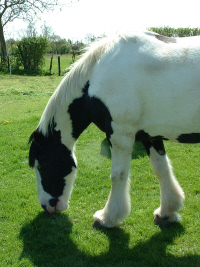A horse’s brain waves can reflect their welfare state according to recent research.
Electrical activity in the brain varies with the state of arousal of the different parts of the brain and the electrical waves have been grouped into bands according to their frequency: eg delta (δ: 0−4 Hz), theta (θ: 4−8 Hz), alpha (α: 8–12 Hz), beta (β: 12–30 Hz) and gamma (γ: >30 Hz).
Theta waves tend to predominate during calm and relaxed states, while an alert state tends to produce more gamma waves.
Mathilde Stomp and colleagues at the University of Rennes, France, devised a headband for horses, to record the resting electrical activity in the brain (EEG – electroencephalogram). Then, to see if there was an association with the horses’ welfare state, they compared the patterns of electrical activity with an assessment of the horses’ behaviour.
Eighteen horses involved in the study were maintained under either “restricted” conditions (living in riding school stables with a few hours daily turnout on pasture and regular work) and “leisure” (on pasture all year round, with occasional leisure riding.)
The researchers found that theta waves tended to predominate in both sides of the brain in horses in a more positive welfare state, whereas beta waves tended to predominate in horses showing signs of compromised welfare. Horses in a good welfare state produced fewer gamma waves in the right side of the brain.
A full report of the work is published in Applied Animal Behaviour Science. The authors suggest that “bilateral and left hemisphere theta activity is a promising neurophysiological marker of good welfare in horses, while a bilateral or RH [right hemisphere] high production of gamma waves should alert about potential welfare alterations.”
For more details, see:
Brain activity reflects (chronic) welfare state: Evidence from individual electroencephalography profiles in an animal model.
M. Stomp, S. d’Ingeo, S. Henry, H. Cousillas, M. Hausberger.
Applied Animal Behaviour Science, (2021) vol 236, 105271.


2 comments:
I'm intrigued by the authors' definition of "compromised welfare". Surely there must be more detailed explanations forthcoming? I would have though age, perhaps breed, conditions of feeding stabling, handling and riding ability of owners, staff would come into it as well? Looking forward to hear more please.
And is brain electrical activity in their eyes the same as behaviour?
I wonder how these findings would compare with horses in similar situations in the Uk as opposed to the author's France?
“Compromised” perhaps sounds more severe than it was.
In the original research, (https://www.sciencedirect.com/science/article/pii/S0168159121000587) horses described as “restricted” or with “compromised welfare” were “kept in 3 × 3 m individual straw bedded stalls in a barn (with door openings and grids in the wall allowing visual contact with conspecifics), fed industrial pellets twice a day (morning: 9:30; evening: 6:00) and hay (6−7 kg) once a day (9am), and were working in riding lessons (including being ridden by riders from beginner to experienced) for 4–12 h per week under the supervision of a riding teacher.”
In contrast, the “leisure” group were on pasture all year round, with occasional leisure riding.
Post a Comment